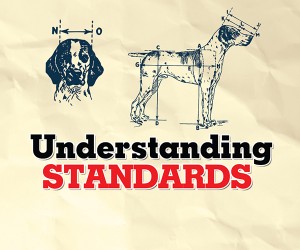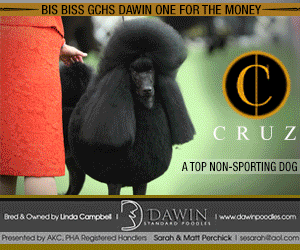Understanding Standards
Click here to read the complete article
By the time most exhibitors of purebred dogs make their first trip into the show ring, they have narrowed their interest to one breed. About the time they make their second ring appearance, they will have learned that there exists differences in the quality of dogs within their breed. Those differences may be recognized on a varying scale of values between puppies and adults, as well as those which are pet quality, those competing in companion and performance events, and those that are conformation champions and breeding stock.
It is a maxim, which is almost universally accepted, that “beauty is in the eye of the beholder.” However, when this particular type of beauty is to be assessed and debated between two breed enthusiasts, or among any number of purebred dog owners (say, for example, at a dog show or club meeting), the “eyes” of a few of the “beholders” will likely require some amount of stabilizing guidance in finding agreement, in principle, yet still allowing for individual interpretation.
And, even before a breed is granted full recognition and assigned a group classification, it is necessary that an authoritative description be submitted and adopted. This definitive document then becomes the breed’s “Standard of Perfection.” After approval by the American Kennel Club, it becomes the “frame of reference” in the difference of opinion between estimates of “beauty” in the “eyes” of the many different “beholders.”
What is a breed standard?
A breed standard is, essentially, a written illustration of what a dog of the given breed should look like. The words paint a picture of the correct construction and ideal movement. A breed standard should describe everything from head to tail, front to rear, height and weight, coat and color, as well as proportion and ratio. It describes the key traits and characteristics of the breed and–in the well-thought-out standards–physical and mental soundness are also mentioned.
The breed standards are what lie behind the 193 different breeds that we know and enjoy today. They are the blueprints used by breeders in their pursuit to breed only superior specimens and they are the tool of the judges in evaluating the merits of the dogs in the conformation ring.
On occasion, there is a grading scale for specific traits and characteristics ranging from barely tolerable to highly desirable. Often, the mention of qualities, at any point on such a scale, should not be interpreted as more to be sought than the stated intent. And, with respect to portions of standards adopted from foreign countries of the breed’s origin, it may be crucial to know how it is (or was) applied there in order to ensure equal effectiveness here and now.
History of breed standards
Click here to read the complete article
Short URL: https://caninechronicle.com/?p=177779
Comments are closed












